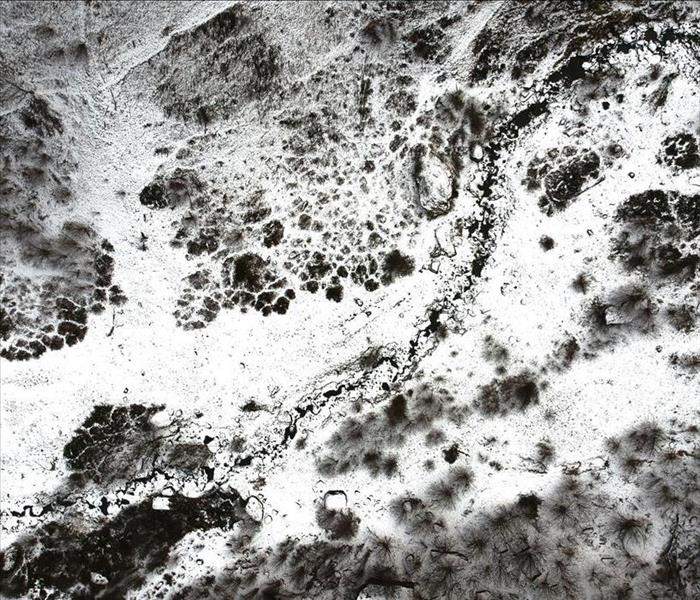Is Black Mold Covered By Insurance?
12/29/2020 (Permalink)
Your Homeowners Insurance May Cover Your Black Mold Claim
As researchers name it, black mold, or Stachybotrys chartarum, is a tiny mold characterized by its darkened color. It occurs in areas that are damp, moist, or humid. Black mold development can harm structures and entail comprehensive cleanup, maintenance, and extraordinary measures to avoid future development. Black mold spreads quickly throughout a property and causes carpet odors; that is why it's best to get it addressed and removed ASAP.
Mold is a fungus that can be located nearly anywhere in and out of your house. However, certain mold types are deemed dangerous, like black mold, which may contain contaminants that can damage your home's structure. It can cause significant damage to the items in your home as well. Often, owners are protected by mold insurance, but not always. The coverage relies on the policy and what has induced the mold to grow.
Continue reading to find out when your homeowners' policy protects against mold damage.
For years, mold was a very controversial subject in the home insurance sector. When insurance companies or agencies insured mold damage, insurance agencies compensated thousands and thousands of dollars in premiums. Insurers soon found that shielding mold was too dangerous to undertake; thus, most policies now only provide minimal coverage, if any.
Molds created due to immediate and unintentional water damage, such as a burst drain, are usually protected by homeowners' policy. Still, mold formed with time attributable to excessive humidity, leaky pipes, or floods may not be insured by your insurance provider.
Did you know a homeowners insurance policy will not insure damage incurred by maintenance issues or inaction? When the insurance claims that mold development in your house was avoidable or that the mold was in place before, your claim will most likely be rejected.
When Is Mold Damage Covered By Insurance?
Most homeowners' insurance includes mold contamination if induced by a "covered peril." In some conditions, traditional homeowners' policies include mold damage. Suppose the mold is the consequence of a protected risk—like water damage— incurred by unexpected and unintentional accidents. In that case, the repair and cleanup of the mold are expected to be covered by your insurance company. So if you have mold in your house or your pipes spontaneously break, there's a fair possibility that your insurer can offset the expense of repairs.
The estimated cost that the insurer spends for mold claims could vary from 1,000 to 100,000 dollars depending on the amount of damage that is present at the property. While mold can be subject to homeowners' insurance in some cases, coverage for fungus damage is generally limited.
How To Avoid Your Black Mold Claim From Being Declined
You can perform various measures to increase the likelihood of your claim being accepted if you experience mold damage. Mold is often typically found in regions of higher humidity. That could involve leaking water pipes or basements with drainage problems, and equipment hoses, leaky roof.
To prevent mold damage, you can do the following:
- Place dehumidifiers in places that are damp-resistant
- Using air conditioners or dehumidifiers to maintain your home's relative humidity around 30% to 50%
- Address plumbing issues as quickly as possible
- Thoroughly monitor plumbing pipes to check leakage.
- Prevent the insertion of carpets in wet areas
- Keeping the gutters clear to avoid ice jams in the winter that can contribute to leakage
- Suitably ventilate bathrooms, laundry rooms, bedrooms, as well as other parts of your house where mold can have the potential to spread.
- Use fans to guarantee sufficient airflow.
- Properly insulate indoor and outdoor pipes in winter to prevent breakage or leakage.
- Remove stagnant water and other types of water damage.
- Check hoses and valves every week to avoid leakage.
If you have to claim damages of the mold, then:
- Record the damage appropriately with images and video
- Supply your insurance adjuster with an updated servicing report
- Take all directions that the insurance provider sends you to handle the claim.
- Contract licensed mold removal company like SERVPRO to mitigate the damages
Steps To Take If Your Claim Is Declined
If your insurance provider rejects your mold claim, you may need a qualified professional to give a second view about what induced the damage. You can also decide to contest the refusal against the insurance provider if it has a clear appeal policy. If that's not the case, the state insurance agent will be willing to assist with what you can expect to have the claim accepted or to submit a rejection complaint.
SERVPRO Insurance Claim Specialists
Did you know that SERVPRO will help you file a homeowners insurance claim with your insurance company? SERVPRO of Union, Towns, Fannin & Gilmer Counties has over 50 years of combined experience working with insurance adjusters. We have partnerships with many insurance companies and are a preferred insurance vendor. Contact us today for a mold estimate, and we promise to get your property back "Like it never even happened."





 24/7 Emergency Service
24/7 Emergency Service
